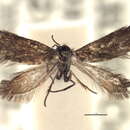Comprehensive Description
provided by Smithsonian Contributions to Zoology
Eriocraniella (Eriocraniella) longifurcula
ADULT (Figure 176).—Wing Expanse:, 9.5–10 mm.
Head: Sparsely covered with whitish to grayish hairs. Antennae of moderate length, approximately 0.5 the length of forewing, 36-segmented; scape fuscous above, irrorated with white beneath; flagellum mostly covered with slender fuscous scales except for a narrow streak of pubescence ventrally. Maxillary palpi fuscous, slightly irrorated with white ventrally; apex of terminal (5th) segment very similar in structure to E. platyptera, with a series of minute lobes arranged in 3 ranks as follows: (a) a single, relatively large apical lobe bearing 4 moderately long subacute setae, (b) an identical pair of much shorter subapical lobes, each bearing a single, elongate subacute seta, and (c) an identical pair of very short subapical lobes, each with a single, elongate subacute seta. Base of galeae sparsely scaled with fuscous. Labial palpi fuscous with a slight whitish irroration on apical segment.
Thorax: Dorsum fuscous; tegulae with long whitish and fuscous hairs; collar with long, mostly whitish hairs. Venter whitish. Legs fuscous above, mostly white ventrally. Forewings relatively slender, width about 0.3 the length, immaculate, fuscous with a slight bluish purple iridescence; fringe uniformly fuscous. Hind wings slightly paler than forewings in color, grayish, uniformly covered with relatively broad scales.
Abdomen (Figure 233): Thinly covered with fuscous hairs above, more grayish ventrally. Fourth sternite of male without fenestrae. Sternal tubercules present on 5th sternite, tubular in form, diameter approximately 0.17 the length of sternite.
Male Genitalia (Figures 269–270): Uncus deeply bilobed; lobes prominent, distinctly curved laterally, lobes widely separated at apex for a distance slightly greater than their length. Anal tube completely membranous, without basal sclerites. Vinculum with lateral arms of furcula greatly extended, slender; furcula divided approximately 0.7–0.8 its entire length; median cephalic margin of vinculum between apophyses smoothly concave, without median process; apophyses elongate, approximately 0.8 the length of undivided vinculum (excluding furcula). Juxta broad, with lateral margins nearly parallel; greatest width about 0.75 its length; caudal apex broadly truncate. Base of aedeagus greatly swollen, bulbous; ventral phallic branch stout, equaling diameter of dorsal branch; apex of ventral branch with a minute, flabellate serrated lobe bearing 5–7 marginal teeth; dorsal branch with a short, broadly conical, acute process arising subapically; ventral branch loosely articulated to bulbous base of aedeagus.
LARVA (Figures 147–161).—Length of largest larva 7 mm; diameter 1 mm.
Head: Uniformly light brown to stramineous with frontal sutures darkly outlined. Greatest width 0.5 mm; length 0.6 mm. Va variable, either laterad or posterior to VI. Pl relatively elongate, several times larger than A2, either contiguous or slightly separate from ecdysial line. A2 usually well separated from and laterad to Pl. A1 present. Labrum similar to E. aurosparsella, with apices of M2, M3, and L3 broadly compressed (Figure 155); ventral margins of foregoing setae entire, not dentate as in E. aurosparsella; M3 arising approximately equidistant between M2 and L3; anterior margin of pilifers and epipharynx spinose. Mandibles with inner margin smooth; median setal tufts absent.
Thorax: Pronotal and prosternal plates well developed, dark brown. Meso and metathorax with out plates, whitish. L2 reduced in size on meso- and metathorax, approximately 0.3–0.5 the length of L1. Subventral setae bisetose on prothorax.
Abdomen: Integument without pigmentation, usually whitish (in alcohol) except for a pair of minute, longitudinal brownish spots near lateroposterior margin of anal segment; barlike spots similar to those of E. aurosparsella in form, with cephalic end slightly enlarged and punctate. L1 absent on I to VIII. SD2 typically present on I to VIII. Segment IX with 7 pair of setae; SD2, L3, and SV3 absent.
HOLOTYPE.—, Workman Creek, Sierra Ancha [Mts.], Gila County, Arizona, 3 May 1947, H. and M. Townes, USNM 72101, genitalia slide USNM 18071; in the National Museum of Natural History, Smithsonian Institution.
PARATYPE.—ARIZONA: Coconino Co: Oak Cr Canyon: 1 , 25 May 1974, 5200 ft [1585 m], genitalia slide DRD 2959, wing slide 2990, R. Leuschner (RHL). Described from 2 males.
Other Material Examined: ARIZONA: Coconino Co: North Rim Oak Cr Canyon: 3 larvae, 3 Jun 1968, coll. P. Opler, on Quercus gambelli X arizonica, JAP 68F13, larval slides DRD 3010, 3020 (UCB); same data: 2 larvae, larval slides USNM 18146, 18147, (USNM).
HOST.—Uncertain; possibly Fagaceae: “Quercus gambelli Nutt. X arizonica Sarg.,” from specimen labels.
FLIGHT PERIOD.—May; probably univoltine.
DISTRIBUTION (Map 3).—This species is presently known from only two sites located in adjacent counties of central Arizona.
- bibliographic citation
- Davis, Donald R. 1978. "A Revision of the North American Moths of the Superfamily Eriocranioidea with the proposal of a New Family, Acanthopteroctetidae (Lepidoptera)." Smithsonian Contributions to Zoology. 1-131. https://doi.org/10.5479/si.00810282.251
Eriocraniella longifurcula: Brief Summary
provided by wikipedia EN
Eriocraniella longifurcula is a moth of the family Eriocraniidae. It was described by Davis in 1978. It is found in central Arizona.
The wingspan is 9.5–10 mm for males. The forewings are relatively slender and immaculate, fuscous with a slight bluish purple iridescence. The hindwings are slightly paler than the forewings, grayish, uniformly covered with relatively broad scales. Adults are on wing in May, probably in one generation per year.
The larvae possibly feed on Fagaceae species. They have a dark brown body and a uniformly light brown to stramineous head
- license
- cc-by-sa-3.0
- copyright
- Wikipedia authors and editors

